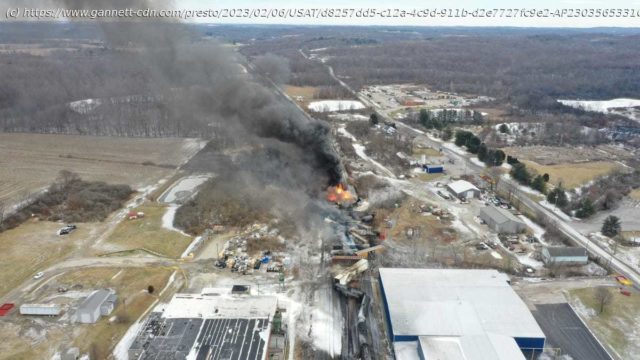Array
Norfolk Southern, the company behind the Ohio chemical spill, fought against a new U.S. Department of Transportation safety rule that may have helped limit the impact of this month’s derailment.
As railroad operators have faced more competition with long-haul truckers, the major companies have worked to decrease costs, including by cutting the workforce.
Overall train length and weight have both grown over the last decade partly in an effort by companies to be more efficient. But, when an emergency occurs, stopping quickly with heavier, longer trains is far more difficult.
In 2013, a train derailment and subsequent fire in Lac-Mégantic, Quebec, killed 47 people and required all but three downtown buildings to be demolished for safety reasons. The following year, a derailment in Casselton, North Dakota, spilled nearly 500,000 gallons of crude oil and caused $13.5 million in damage, prompting the Obama administration to push for a new safety rule to govern the transportation of hazardous materials, avoid environmental disasters and save lives.
The effort to create a new safety rule was fought by industry lobbyists, including Norfolk Southern Corp., the Atlanta-based company whose train derailed in eastern Ohio and spilled chemicals earlier this month, leaving residents in East Palestine worried about their air, soil and water quality.
When the safety rule was issued in 2015, however, it was narrowly crafted and required only electronically controlled brakes – which applies braking simultaneously across a train rather than railcar by railcar over a span of seconds – to be installed by 2023. It applied only to certain “high-hazard flammable trains” carrying at least 20 consecutive loaded cars filled with liquids like crude oil.
The Trump administration repealed the rule three years later, stating that its cost exceeded the benefits.
Efforts to reduce costs including lobbying against costly regulation, increasing train lengths, reduced inspection times and major cuts to the railroad workforce have made trains less safe, labor representatives and industry experts told USA TODAY, increasing the potential for accidents like the one in Ohio to become more common.
Still, in general, major derailments leading to public evacuations, chemical spills or loss of life are relatively rare compared with the vast amounts of hazmat cargo railroads transit.
We crunched the numbers: How often do train wrecks spill hazardous chemicals into neighborhoods?
Had industry lobbying interests not prevailed on the 2015 rule, the Norfolk Southern Railway train involved in the Feb. 3 derailment may have been equipped with the better braking system, shown in studies to reduce the size of a derailment pile up when emergency braking is applied.
“ECP brakes would have avoided that monster pile up behind the derailed car,” said Steven Ditmeyer, a former senior official at the Federal Railroad Administration. “In fact, depending on when the crew got the (error) notice from the wayside detector, applying the ECP brakes would have stopped everything very quickly.
“So I think it would have helped.”
Norfolk Southern referred to the industry group, the Association of American Railroads for comment, around lobbying over ECP brakes.
Association of American Railroads spokeswoman Jessica Kahanek said in an emailed statement that several railroad operators have tested out ECP brakes and found them to have a “significant” failure rate and lengthy repair time that makes them impractical.
When such electronically controlled brakes fail, she said, trains become immovable and it can cause major disruptions. So instead, railroads use locomotives throughout a train to try to distribute a brake signal more quickly among cars, Kahanek said.
In a 2017 report, the National Academy of Sciences said it was unable to “make a conclusive statement about the emergency performance of ECP brakes” compared with other braking systems based on the results of the provided DOT testing and analysis.What is precision scheduled railroading?
The rule-making saga and its ultimate repeal are emblematic of the politically and financially difficult task of making improvements to the nation’s railroad system, which has left the industry mostly stuck with post-Civil War-era technology in its braking systems, even as other new technologies meant to streamline operations, are adopted.
Railroad operators have seen increasing competition from long-haul truck drivers for transporting goods to such a degree that over the last decades its executives have instituted a business philosophy known as precision scheduled railroading, which focuses on maximizing the use of trains by the individual carload, that has led to longer, heavier trains crisscrossing the nation’s railroad tracks in the name of efficiency and better shareholder returns.
Home
United States
USA — Events Trains are becoming less safe. Why the Ohio derailment disaster could happen...






